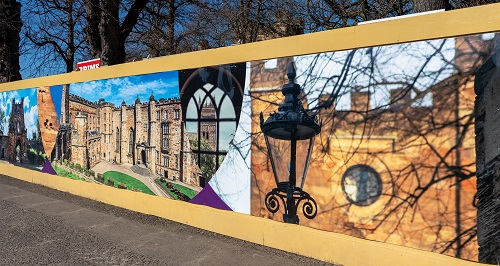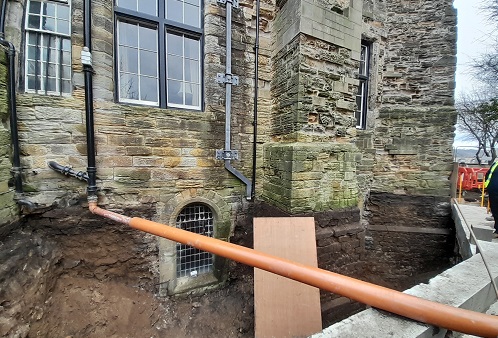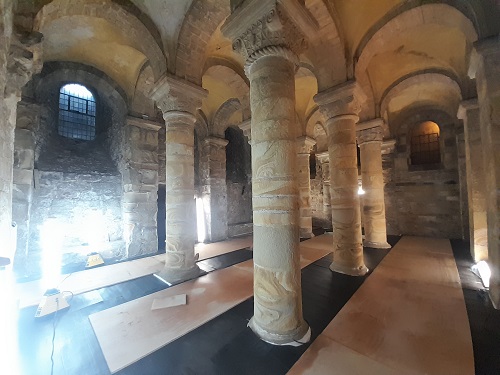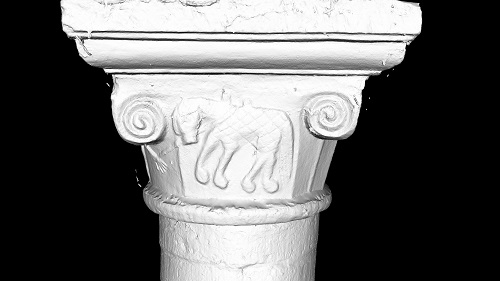Norman Chapel Project - Update

Work is now well underway on the first phase of the Norman Chapel Conservation Project. Visitors to Palace Green will be aware of the on-going work, with contractors and building equipment on site since November 2022. This first phase of the project has been part funded with £80k provided by the Wolfson Foundation towards the cost of restoration.
The most obvious sign of the work is the scaffolding bridge erected in the grounds of Durham Castle, to allow safe access to and from the North Terrace for the construction teams working on site. The bridge also allows delivery and removal of plant and other equipment to the site, with minimal disruption.

We have taken advantage of the protective hoardings installed around the Castle to create an informative series of panels. As well as dressing the site, these panels provide information on the project and the works being carried out. The panels also allow the University to communicate its leading role in the project and commitment to preserving the history and culture of the city by promoting other aspects of the World Heritage Site to visitors.
Exterior work
The auger boring activity to construct the piles for the retaining wall of the trench alongside Norman Chapel was completed successfully in January. This meant work could begin on the excavation of the trench around the outside wall of the Chapel, it will be up to 5 metres deep and has already revealed the original exterior wall, buried for centuries. A retaining wall and ring beam have been installed to support the trench, so our archaeologists and stonemasons can work safely.
Tobit Curteis Associates, leaders in the field of environmental survey and monitoring techniques for the study of historic building performance are closely involved with the project. They are experts in studying the environment to diagnose and make recommendations to control deterioration in buildings and collections.

All work on the Norman Chapel and around the Castle is progressing under a strict archaeological watching brief to identify and assess any unexpected issues or archaeological finds that may come to light. For example, during excavation works on site, the original external terrace wall was uncovered, our archaeologists believe this is medieval and may be as old as parts of the Castle. Our Archaeological Services are now investigating the history and purpose of this wall and we are in the process of briefing Durham County Council Conservation Planners and Historic England to agree how best to proceed.
Inside the Chapel
Specialist stone conservators from Hirst Conservation have been busy inside the Chapel, carrying out essential work to allow the stone to dry out safely. This involves carefully removing old mortar used to repair the external walls over the centuries. The old mortar will be replaced temporarily, with new porous mortar, which will draw damaging salts and moisture from the walls. This will help with the drying out and prevent any further damage. The first drying out phase of the process is expected to take around 5 years. Once the walls are completely dried, the damage will be assessed and next phase of the restoration work will begin on the long term conservation of the Chapel.

While specialist have been working inside the Chapel, they have also identified that the ceiling and an interior wall of the Chapel are holding moisture and contributing to the damp in the stonework. This unanticipated issue is currently being investigated and the best course of action agreed, to allow the interior of the Chapel to fully dry out.
Factum Arte
We are working in collaboration with Factum Arte, a team of artists, technicians and conservators dedicated to digital mediation, to document the Chapel as a cultural heritage site and develop new techniques of digital preservation and restoration. In January, a team from Factum Arte carried out the first stage of a complete 3D recording of the Chapel, using photogrammetry and a LiDAR scanner. The aim of the 3D recording is to provide further insight into the questions that still surround the making and materials behind the 11th-century chapel and to help inform the restoration project by providing accurate surface and colour information. Having returned twice more to complete the scanning, Factum Arte are now assessing the information they have gathered and will be making recommendations on how to preserve the stonework for the future.

Next steps
Work on the stone will be paused during the exam period from early May to mid-June, so students living and studying in the Castle are not disturbed.
The good news for visitors, is that the Chapel will be able to be re-opened over the Summer as part of the Castle Guided Tour, until the next phase of work is due to begin. This will offer visitors the opportunity to see the work to date and to learn more about the future plans for the Chapel
Find out more
- Visit the Norman Chapel Restoration Project website
- Take a guided tour of Durham Castle
- Discover Durham's World Heritage Site
- Visit the The Wolfson Foundation website
- Visit Tobit Curteis Associates website
- Explore the work of Hirst conservation
- Learn more about our collaboration with Factum Arte


/prod01/prodbucket01/media/training/BBL6-3492X1127.jpg)